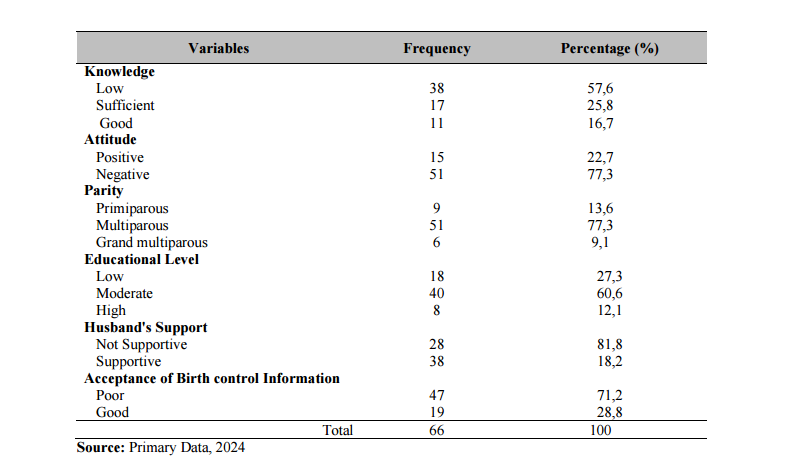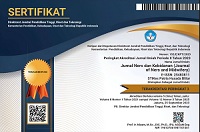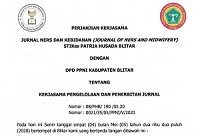Factors Associated with Mothers’ Interest in Choosing Intrauterine Contraceptive Device (IUD) at Moti Health Center, Ternate City, North Maluku Province
DOI:
https://doi.org/10.26699/jnk.v12i2.ART.p133-141Keywords:
Maternal Knowledge, Attitude, Parity, Education, Husband's Support, Acceptance of Birth control Information, Interest in IUDAbstract
The utilization of intrauterine devices (IUDs) remains low in Maluku Province, with a reported adoption rate of only 33.9% in 2020. At the Moti Community Health Center in 2022, IUD usage was recorded at just 0.19%. This study aimed to identify factors influencing the interest in choosing IUD at the Moti Community Health Center in Ternate City, North Maluku Province. Using a quantitative cross-sectional design, the research employed multistage random sampling involving 66 women of reproductive age (WRA). Data collection utilized questionnaires and interviews, with statistical analysis including univariate and bivariate analyses using Chi-Square tests. Out of 66 respondents, 19 (28.8%) expressed interest in choosing IUD, while 47 (71.2%) did not. Chi-square analysis revealed significant correlations between interest in IUD and variables such as knowledge (p-value 0.002), attitude (p-value 0.031), education (p-value 0.027), husband's support (p-value 0.000), and acceptance of birth control information (p-value 0.001). However, parity showed no significant association (p-value 0.624) with mothers' interest in choosing IUD at the Moti Health Center in Ternate City, North Maluku Province. Significant relationships were observed for variables like knowledge and attitude, whereas parity did not demonstrate a notable link. Increasing IUD adoption among WRA requires enhanced education, family involvement, flexible services, and competent healthcare providers. Encouraging husbands’ participation, structured counselling, home visits, and incentives can boost uptake. These findings highlight the need for training the staff, and collaborating with community leaders to increase IUD adoption.
References
Abbas, M., Hadijono, S., Emilia, O., & Hartono, E. (2019). Pengaruh Konseling Saat Persalinan Terhadap Kepesertaan Keluarga Berencana Pasca Salin di Kabupaten Koalaka. Jurnal Kesehatan Reproduksi, 4(2), 132–133. https://doi.org/10.22146/jkr.35425. Pengaruh Konseling saat Persalinan terhadap Kepesertaan Keluarga Berencana Pasca Salin di Kabupaten Kolaka | Abbas | Jurnal Kesehatan Reproduksi
Ashraf, N., Field, E., Voena, A., & Ziparo, R. (2022). Maternal Mortality Risk and Spousal Differences in the Demand for Children. SSRN Electronic Journal. http://www.nber.org/papers/w28220
Astuti, E. (2018). Faktor yang mempengaruhi minat ibu untuk menggunakan kontrasepsi IUD Di BPS Mien Hendro. Jurnal Kebidanan Stikes William Booth, 6(1), 1–6. https://jurnal.stikeswilliambooth.ac.id/index.php/Keb/article/view/197
Badan Pusat Statistik (LF SP2020). (2023). Hasil Long Form Sensus Penduduk 2020. In Berita Resmi Statistik. https://papua.bps.go.id/pressrelease/2018/05/07/336/indeks-pembangunan-manusia-provinsi-papua-tahun-2017.html
Bernadus, J. D., Madianung, A., & Masi, G. (2013). Faktor-Faktor Yang Berhubungan Dengan Pemilihan Alat Kontrasepsi Dalam Rahim (IUD) Bagi Akseptor Kb Di Puskesmas Jailolo. E-NERS, 1(1), 1–10. https://doi.org/10.35790/ens.v1i1.1760
Berndt, V. K., & Bell, A. V. (2021). “This is what the truth is”: Provider-patient interactions serving as barriers to contraception. Health (United Kingdom), 25(5), 613–629. https://doi.org/10.1177/1363459320969775
BKKBN. (2021). Pendampingan Keluarga Ibu Hamil dan Pasca Persalinan. 54. https://lms-elearning.bkkbn.go.id/mod/resource/view.php?id=3097&forceview=1
Cleland, J., Conde-Agudelo, A., Peterson, H., Ross, J., & Tsui, A. (2012). Contraception and health. The Lancet, 380(9837), 149–156. https://doi.org/10.1016/S0140-6736(12)60609-6
Harefa, N., & Ndruru, E. (2022). Determinan Minat Ibu dalam Pemilihan Kontrasepsi IUD di Wilayah Kerja Puskesmas Mandrehe Utara Kabupaten Nias Barat. Journal of Issues in Midwifery, 6(3), 115–130. https://doi.org/10.21776/ub.JOIM.2022.006.03.1
Harrison, C. V., Igwe-Kalu, C., & Eide, L. (2023). An Integrative Review of Extended Use of Intrauterine Devices. Nursing for Women’s Health, 27(6), 427–434. https://doi.org/10.1016/j.nwh.2023.06.005
Kamil Rusda Yani, A. (2021). Faktor-Faktor Yang Berhubungan Dengan Rendahnya Penggunaan Kontrasepsi Intra Uterine Device Di Puskesmas Wajok Hulu. Jurnal_Kebidanan, 11(1), 560–568. https://doi.org/10.33486/jurnal_kebidanan.v11i1.133
Kuncaraning, R., Yugiana, E., & Noviani, A. (2021). Profil Statistik Kesehatan 2021. In I. E. Harahap, S. P. Astuti, & S. H. Ponco (Eds.), Badan Pusat Statistik (4201005th ed.). Badan Pusat Statistik. bps.go.id
Kyejo, W., Rubagumya, D., Mwalo, C., Moshi, L., Kaguta, M., Mgonja, M., & Jaiswal, S. (2022). “Do not detach the placenta from my baby’s cord” - Lotus birth case series from Tanzania tertiary hospital. International Journal of Surgery Case Reports, 99(September), 107/630. https://doi.org/10.1016/j.ijscr.2022.107630
Manzer, J. L., & Bell, A. V. (2022). “Did I Choose a Birth Control Method Yet?”: Health Care and Women’s Contraceptive Decision-Making. Qualitative Health Research, 32(1), 80–94. https://doi.org/10.1177/10497323211004081
Mentari, T. S., & Artikel, I. (2020). Higeia Journal of Public Health. Higeia Journal of Public Health Research and Development, 4(4), 610–620. https://doi.org/10.15294/higeia/v4i4/34767
Munawaroh, M., Ratnawati, E., Ningsih, T. Z., & Nuryana, N. (2022). Enhancing Students’ Communication Skills in Social Studies Learning Through Cooperative Learning. Ta’dib, 25(1), 71. https://doi.org/10.31958/jt.v25i1.5826
Mutika, W. T., Susiyana, S., Catur Putri, A. G., Riyani, A. F., & Sadela, S. (2022). Evaluasi Pelayanan Kia-Kb. Jurnal Sains Kebidanan, 4(1), 1–6. https://doi.org/10.31983/jsk.v4i1.8407
Nuraini, Wahyuni, S., Windiarto, T., Oktavia, E., & Karyono, Y. (2018). Profil Penduduk Indonesia Hasil Supas. In D. Handiyatmo, Parwoto, & Widaryatmo (Eds.), Analytical Biochemistry (2101033rd ed., Vol. 11, Issue 1). Badan Pusat Statistik. http://link.springer.com/10.1007/978-3-319-59379-1%0Ahttp://dx.doi.org/10.1016/B978-0-12-420070-8.00002-7%0Ahttp://dx.doi.org/10.1016/j.ab.2015.03.024%0Ahttps://doi.org/10.1080/07352689.2018.1441103%0Ahttp://www.chile.bmw-motorrad.cl/sync/showroom/lam/es/
Octavi, F. Della, Lestari, F., & Munir, R. (2022). Hubungan Tingkat Pengetahuan ibu dengan Minat terhadap Penggunaan Alat Kontrasepsi Dalam Rahim (IUD) Pasca bersalin. Journal of Midwifery Care, 2(02), 133–142. https://doi.org/10.34305/jmc.v2i2.419
Patimah, P., & Nurani, L. (2022). Faktor-Faktor yang Berhubungan Minat Ibu dalam Pemilihan Alat Kontrasepsi Iud pada Wanita Usia Subur di Desa Cimanggu Kecamatan Cibeber Kabupaten Cianjur. Malahayati Nursing Journal, 4(9), 2350–2365. https://doi.org/10.33024/mnj.v4i9.7001
Perwira, R. G., Ratnawati, R., & Abidin, Z. (2022). Faktor yang Berhubungan dengan Pemilihan Alat Kontrasepsi IUD pada Pasangan Usia Subur di Puskesmas Banjarejo Kota Madiun. Jurnal Surya Medika, 7(2), 147–152. https://doi.org/10.33084/jsm.v7i2.2672
Petrie, K. A., McCoy, E. E., & Benson, L. S. (2024). IUD self-removal: A randomized controlled trial of a self-removal guide in clinical and nonclinical settings. Contraception, 135, 110421. https://doi.org/10.1016/j.contraception.2024.110421
Priyono, & Kusumawati, P. (2020). Studi Fenomenologi Penggunaan Metode Kontrasepsi Jangka Panjang (MKJP) di Wilayah Kampung KB Desa Mlese, Ceper, Klaten. Jurnal Kesehatan Indonesia, 1–6. www.jakarta.go.id
Puskesmas Moti. (2022). Profil Puskesmas Moti 2022. https://www.scribd.com/document/436476216/BAB-II-Profil-Pkm
Steare, T., Gutiérrez Muñoz, C., Sullivan, A., & Lewis, G. (2023). The association between academic pressure and adolescent mental health problems: A systematic review. Journal of Affective Disorders, 339, 302–317. https://doi.org/10.1016/j.jad.2023.07.028
Syum, H., Kahsay, G., Huluf, T., Beyene, B., Gerensea, H., Gidey, G., Desta, H., Abay, M., Nuguse, H., & Haile, K. (2019). Intention to use long-acting and permanent contraceptive methods and associated factors in health institutions of Aksum Town, North Ethiopia. BMC Research Notes, 12(1), 1–6. https://doi.org/10.1186/s13104-019-4769-z
Widgery, D. (1988). Health Statistics. In Science as Culture (Vol. 1, Issue 4). https://doi.org/10.1080/09505438809526230

Downloads
Published
How to Cite
Issue
Section
License
Copyright (c) 2025 Jurnal Ners dan Kebidanan (Journal of Ners and Midwifery)

This work is licensed under a Creative Commons Attribution-ShareAlike 4.0 International License.


 Google Scholar
Google Scholar Sinta
Sinta ORCID
ORCID
 Universitas Airlangga Surabaya - Indonesia
Universitas Airlangga Surabaya - Indonesia Google Scholar
Google Scholar Sinta
Sinta
 Scopus
Scopus



